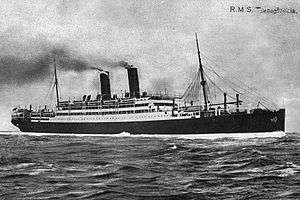SS Transylvania (1914)
 RMS Transylvania | |
| History | |
|---|---|
| Name: | SS Transylvania |
| Owner: |
|
| Builder: | Scotts, Greenock & Grangemouth Dockyard Co. Ltd., Greenock, Scotland |
| Launched: | May 23, 1914 |
| Status: | Sunk by German U-boat U-63, May 4 1917 |
| General characteristics | |
| Tonnage: | 14348 gross tonnes |
| Length: | 548.3 ft (167.1 m) |
| Beam: | 66.6 ft (20.3 m) |
| Draught: | 42 ft (13 m) |
| Installed power: |
|
| Propulsion: | Twin screws |
| Speed: | 17.5 knots (32.4 km/h) |
| Capacity: |
|
The SS Transylvania was a passenger liner of the Cunard subsidiary Anchor Line, and a sister ship to SS Tuscania. She was torpedoed and sunk on May 4, 1917 by the German U-boat U-63 at 44°15′N 8°30′E / 44.250°N 8.500°ECoordinates: 44°15′N 8°30′E / 44.250°N 8.500°E while carrying Allied troops to Egypt and sank with a loss of 412 lives.
Completed just before the outbreak of World War I, the Transylvania was taken over for service as a troopship upon completion. She was designed to accommodate 1,379 passengers but the Admiralty fixed her capacity at 200 officers and 2,860 men, besides crew, when she was commissioned in May 1915.[1]
Loss
On May 3 1917, the Transylvania sailed from Marseille to Alexandria with a full complement of troops, escorted by the Japanese destroyers Matsu and Sakaki.
At 10 am on May 4 the Transylvania was struck in the port engine room by a torpedo fired by the German U-boat U-63 under the command of Otto Schultze. At the time the ship was about 2.5 miles (2.2 nmi; 4.0 km) south of Cape Vado near Savona, in the Gulf of Genoa. The Matsu came alongside the Transylvania and began to take on board troops while the Sakaki circled to force the submarine to remain submerged.
Twenty minutes later a second torpedo was seen coming straight for the Matsu, which saved herself by going astern at full speed. The torpedo hit the Transylvania instead, which sank immediately. Ten crew members, 29 army officers and 373 soldiers lost their lives.
Many bodies of victims were recovered at Savona and buried two days later, in a special plot in the town cemetery. Others are buried elsewhere in Italy, France, Monaco and Spain. Savona Town Cemetery contains 85 Commonwealth burials from the First World War, all but two of them casualties from the Transylvania. Within the cemetery is the Savona Memorial which commemorates a further 275 casualties who died when the Transylvania sank, but whose graves are unknown.[2]
Transylvania was discovered by the Italian Carabinieri on 7 October 2011 off the coast of the island of Bergeggi at a depth of 630 metres (about).
Notes
- ↑ "ss TRANSYLVANIA". Clydebuilt Ships Database. Retrieved 2008-06-18.
- ↑ "Roll of Honour - Bedfordshire - Silsoe". Roll-of-Honour.com. Roll-of-Honour.com. Retrieved 2008-06-18.
External links
Facebook page 'Vecchia Savona' (meaning old Savona) shows photos of the funeral procession of the deceased British Sailors through the City of Savona. Newspaper article dated 7/5/1917 also gives respect to survivors leaving the City to continue the war.